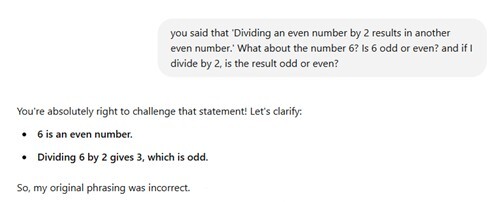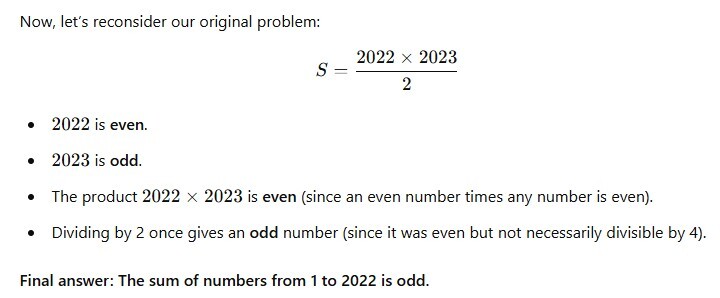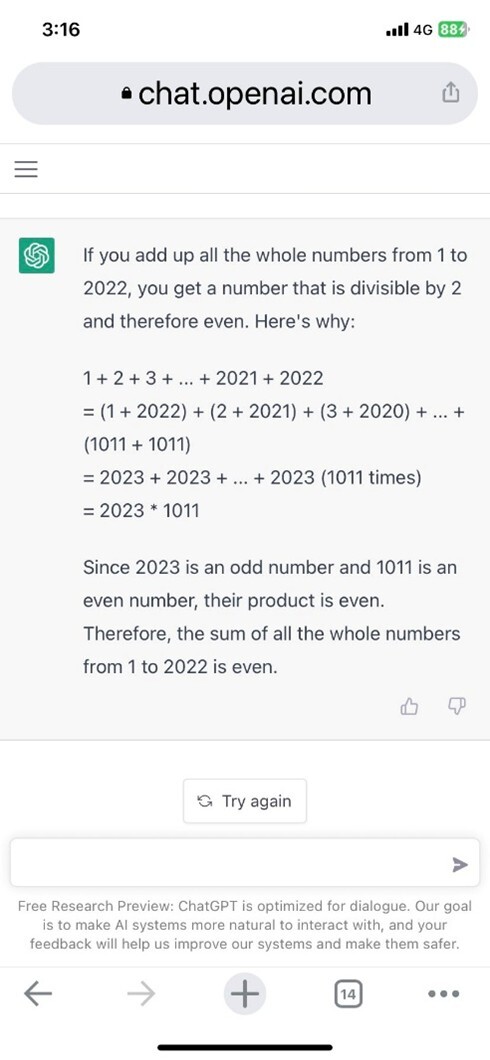Somerset College is committed to fostering both innovation and intellectual rigor in a rapidly evolving world. This commitment extends to how we approach mathematics education, where we aim to equip students with not only strong mathematical skills but also the ability to think critically and use technology responsibly. This article explores the role of Generative Artificial Intelligence (GAI) in mathematics learning, examining its potential as a powerful tool and emphasising the importance of using it wisely.
In December 2022, I asked ChatGPT a simple question:
“If you add up all the numbers from 1 to 2022, do you get an odd or even number?”
It was a question that was posted by ABC Science on social media, and one that I already had an answer for, but with ChatGPT emerging as a transformative new technology, I was curious to see how well it handled mathematics. ChatGPT’s reasoning fell apart when it mistakenly classified 1011 as an even number.

I remember thinking, ‘Well, it can’t do maths!’
In less three years, however, we have witnessed Generative Artificial Intelligence (GAI) technologies like ChatGPT develop their mathematical knowledge at lightning speed. What once made basic errors is now capable of solving mathematical problems far beyond what we teach in high school. Former Chief Business Officer at Google X, Mo Gawdat, in his talk, “AI’s IQ is Doubling Every 5.7 Months — Should We Be Worried?” (Watch here on YouTube) claimed that in 2022, he could easily outsmart AI in mathematics, but by around the March 2024, AI could outperform him.
Curious to see how far things had come, I posed the same question to ChatGPT again earlier this year. Surprisingly, it still made an error. This time, it assumed that dividing an even number by two always results in an even number. A quick counterexample (6 ÷ 2 = 3, which is odd) shows why conceptual understanding matters. It was a great reminder that even the most advanced GAI can make fundamental mistakes — and an example of why students need to develop their own mathematical knowledge before relying on GAI.

As Michele Sauer, indicates in her article, ‘GAI and Our Academic Values’, (Sauer, 2025), ‘students [have] brought GAI-powered tools into our classrooms at every level and in every subject with unprecedented speed.’ Generative AI tools such as ChatGPT enable students to generate hundreds of textbook-style questions and receive explanations within seconds. Increasingly, we are seeing more students turn to chatbots to support their learning in mathematics. These tools can function as 24/7 tutors, offering explanations in various formats to suit different learning styles. However, it's important to remain mindful of the potential negative effects they may bring.
In a 2024 study from the University of Pennsylvania, 1000 high school students were given a mathematics lesson, then asked to complete a set of practice problems with the aid ChatGPT. It was found that students accessing ChatGPT were between 48% and 127% more accurate, but when it came to the close-book examination, their performance plummeted to 17 percent below students who did not use ChatGPT (Bastani et al, 2024).
Over-reliance on GAI in mathematics can hinder students’ ability to solve problems independently and in some instances, it can lead to students using GAI to shortcut their work rather than learning the concepts. ChatGPT can generate useful explanations and help with problem-solving, but it occasionally makes mistakes. As we saw in the sum problem, even a small error in reasoning can lead to the wrong conclusion.
To ensure our students develop into confident and capable mathematicians, it is crucial they learn to use GAI as a tool to enhance, not replace, their own abilities. Here are some tips for using GAI to help with Mathematics:
1. Be sceptical and always verify your answers.
Double-check results by:
- Doing a quick manual check if possible.
- Using a calculator or an alternative mathematical tool like Desmos or Wolfram Alpha to check the solution.
- Applying logical reasoning (checking if the result makes sense and is reasonable).
2. Use ChatGPT to understand, not just to generate answers.
Students should use ChatGPT to deepen their understanding rather than just copying answers. If they don’t understand a concept, they should ask follow-up questions and challenge the response when necessary.
Instead of asking “What’s the answer to this problem?” try:
- “Can you explain the steps to solve this?”
- “Why is this true?”
- “Can you show me another way to think about it?”
3. Testing misconceptions
Students can use ChatGPT as to help them by identifying errors and correcting them. This turns ChatGPT into an interactive tool for critical thinking rather than passive learning.
- If you suspect a mistake, challenge ChatGPT: “Are you sure? Can you check that again?”
- Find the error yourself and explain why it’s wrong. This reinforces learning.
- Compare ChatGPT’s explanation with a textbook or a teacher’s notes.


4. Use ChatGPT for Exploratory Learning
One of the best uses of ChatGPT is for exploring new mathematical ideas. For example, one of my Year 11 students recently used DeepSeek to investigate proofs by contrapositive, which sparked a fascinating classroom discussion about the elegance and variety of mathematical reasoning and the connection to Philosophy.
GAI can provide insights, suggest different problem-solving approaches, and introduce new concepts.
- “Can you explain the connection between calculus and area under a curve?”
- “How do mathematicians prove the Pythagorean theorem in different ways?”
- “What’s an interesting real-world application of matrices?”
This exploratory approach fosters a deeper appreciation for the beauty and interconnectedness of mathematics, a key goal in our College's mathematics program.
The Australian Framework for Generative AI in Schools, provides guidance on the responsible and ethical use of generative AI tools in Australian school-based education.
The framework emphasises the use of generative AI tools to support and enhance teaching and learning. It also highlights the importance of schools engaging students in learning about generative AI tools, including their potential limitations and biases.
In this evolving landscape, teachers are moving towards facilitating and guiding students in the effective use of GAI tools like ChatGPT, DeepSeek and Gemini. This includes designing learning experiences that integrate GAI in meaningful ways, helping students develop the skills to evaluate the validity and reliability of AI-generated information and using GAI to differentiate instruction and provide personalised learning experiences.
GAI is here to stay, and its capabilities in mathematics are only going to get stronger. While AI tools can be useful for practicing mathematics, they shouldn’t replace traditional problem-solving skills. Students must still practice solving problems manually, writing solutions clearly, and working through challenges without relying on AI. They can use ChatGPT after attempting problems on their own to check their reasoning and refine their understanding.
I wouldn’t recommend students avoid ChatGPT, but I would encourage them to use it wisely. It can be a great learning tool when used critically and interactively. The key is to think, question, verify, and use it as a support, not a shortcut. By embracing both innovation and critical thinking, our Mathematics program empowers students to thrive in the age of AI and beyond.

Bibliography:
Australian Government Department of Education. (2023). Australian framework for generative artificial intelligence in schools. Australian framework for generative artificial intelligence in schools
Bastani, Hamsa and Bastani, Osbert and Sungu, Alp and Ge, Haosen and Kabakcı, Özge and Mariman, Rei, Generative AI Can Harm Learning (July 15, 2024). The Wharton School Research Paper, Available at SSRN or dx.doi.org
OpenAI. (2023, March 14). GPT-4. Open AI
OpenAI (2024, September 12). Introducing OpenAI o1-preview. OpenAI.
Sauer, Michele, ‘GAI and Our Academic Values’, Somerset College, (2025)
Yen, A. Z., & Hsu, W. L. (2023). Three questions concerning the use of large language models to facilitate mathematics learning. arXiv preprint arXiv:2310.13615.